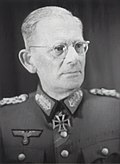This article has multiple issues. Please help improve it or discuss these issues on the talk page . (Learn how and when to remove these messages)
|
| 2nd Army | |
|---|---|
| German: 2. Armee | |
 Insignia | |
| Active | August 1939 October 1939 – April 1945 |
| Country | |
| Branch | |
| Type | Field army |
| Engagements | |
| Commanders | |
| Notable commanders | |
The 2nd Army (German : 2. Armee) was a field army of the German Army during World War II.






